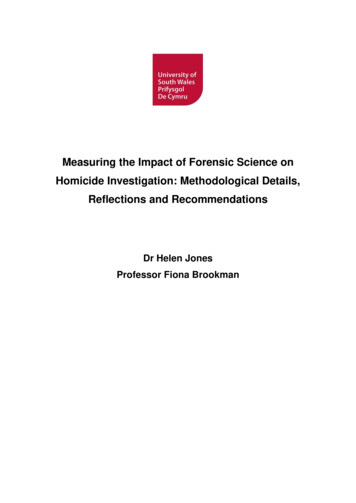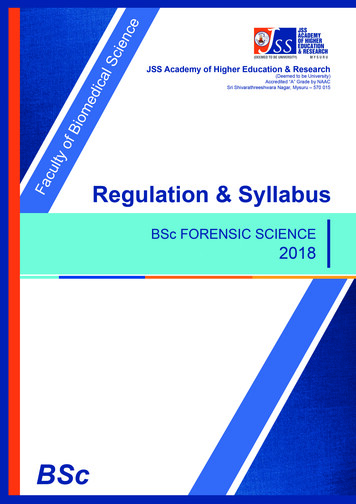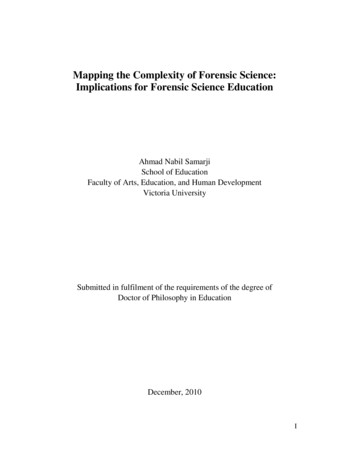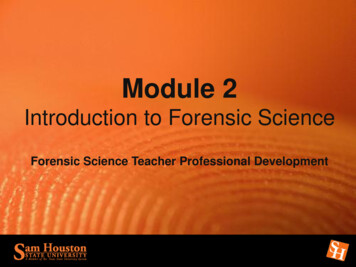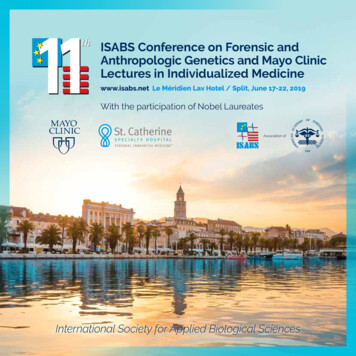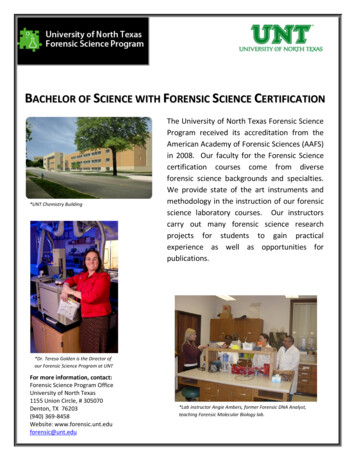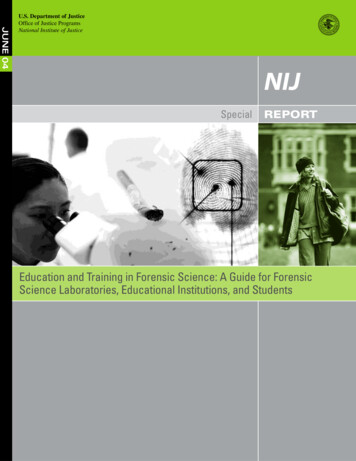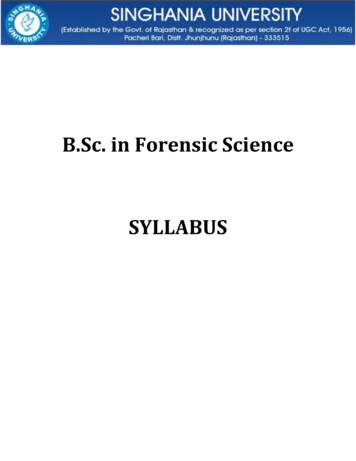
Transcription
B.Sc. in Forensic ScienceSYLLABUS
TOTAL MARKSSLNO123456COURSE TITLE- I SEMHOURSCOMMON COURSE ENGLISHCOMMON COURSE ENGLISHFUNDAMENTALS OF FORENSICSCIENCECOMPLEMENTARY CHEMISTRYCOMPLEMENTARY ZOOLOGYPRACTICAL:FUNDAMENTALS OFFORENSIC 4848808020204880362020FIRST SEMESTER BSc DEGREE PROGRMMECOMMON COURSE IN ENGLISH I (60 hrs)PRACTICAL ENGLISH GRAMMER BY A.J THOMAS – A.V MARTINETTOTAL MARKS- 100MODULE IArticles and one,a little/a few,this,that,a/an (the indefinite article)-Use of a/an -Omission of a/an -a/an and one -a little a few and little/few -the (the indefinite article)-Omission of the -Omission ofthe before home etc. -This/these,that/those -Nouns-Kinds and function -Gender -Plurals -Uncountable nouns -Form of possessive case -Use of possessive case etc.-Compound nouns -Adjectives-Kinds of adjective ,Position of adjective -Order of adjective -Position of adjectives -OrderofadjectivesofThan/as pronoun auxilaryquality-Comparison-The adjective-Constructions-Adjectives s infinitives-Adjectives various-Constructions .Kinds of adverbs -Form and use-Theformation of adverbs -Adjectives and adverbs with the same form -Comparative and superlative -Far,farther/farthest etc.Much,more,most -Constructions with comparisons .Position-Adverbs of
manner-Adverbs of place-Adverbs of time -Adverbs of frequency-Order of adverbs te,hardlyetc.-FairlyandHardly,scarcely,barely -Inversions of the verb-Inversions after certain adverbs -rather-QuiteMODULE IIAll, each, every, both, neither, some, any, no, none- All, each, every, everyone, etc -Both All/both/each ofetc.Neither,either -Some, any, no and none-Someone, anyone, no one etc.Else aftersomeone/anybody etc.Another ,other etc.withone,some -Interrogative :Wh-? Words and how? afterwhotec.-Who,whom,whose,which,what -Who,whom,which and what as objects of prepositions -Use of what-Which compred with who, what interrogative adverbs-Why, when, where, how -Ever afterwho,what etc.-Possessives,personal and and reflexive pronouns:my,mine,I,myself etc.-Possesiveadjectives and pronouns -Agreement and use of possessive adjectives -Possessive pronounsreplacing-Possessive adjectives nouns -Personal pronouns -Position xive pronouns -Emphasing pronouns -Relative pronouns andclauses -Defining relative clausesRelative pronouns used in defining clauses -Relative pronouns used in defining clauses -Definingclauses:persons -Defining clauses:things -Cleft sentences -Relative clause replaecd by infinitive orparticiple -Non-definig relative clauses -Non-defining clauses :persons -All ,both,few,most,severaletc. of whom/which -Non –definig clauses :things -Connective relative clauses sitions -IntroductionAlternative position -Omission of to and forbefore indirect objects -Use and omission of to with verbs of communication -Time vement:from,to -at,in;in,into:on,onto -above,over,under,etc -Prepositions used with adjectivesand participles -Verbs and prepositions Gerunds after prepositions -Prepositions/adverbs .MODULE IIIIntroduction to verbs-Classes of verbs -Principal part -Active tens -Negatives of tenses -Integrattivefor quistions and requestes -Negative in errogative -Auxiliaries verbs-Auxiliries and modals -Formsand patterns -Use of auxiliries in short answers,agreementsetc.In short answers -Agreements and
disagreements-Question tags-Comment tags-Additions to remarks -Be ,have,do-Be as an auxiliaryverbForm and use -Be infinitive -Be as an ordinary verb-Be to denote existence , be adjective -There is / are / was/were etc.-It is and there is compared -Have as an auxiliary verb-Form and use Have object past participle -Had better bare infinitive -Have object present participle -Have asan ordinary verb -Have meaning ‘possess’ -Have meaning ‘take’ , ‘give’ -Do-Form -Do used as anauxiliary -Do used as an ordinary verb -May and can for permission and possibility -Permission Mayfor permission :forms -Can for permission :forms -May and can used for permission in the presentor future -Could or was/were allowed to for permission in the past -Requests for permission PossibilityMay/might forpossibility -May/might perfect infinitive -Could or may/might -Can for possibility -Can and beable for ability -Can and be able:forms -Can/am able,could/was able -Could perfect infinitive -Ought,should,must ,have,to,need for obligation-Ought: -Should:forms -Ought/should compared tomust have to -Ought/should with a continuous infinitive -Ought/should with the perfect infinitive -Must and have to : forms -Must and have to : difference-Need not and must not in the present andfuture -Need not,must not and must in the present and future -Need:forms -Absence of obligation -Need not and other forms -Must,have to and neede in the interrogative -Needn’t perfect infinitive -Needn’t have (done) and didn’t have / need (to do)-Needn’t could and should perfect infinitive To need meaning ‘require’.Must,have,will and should for deduction and assumption-Must for reduction -Must compared tomay/might -Have/had for deduction -Can’t and couldn’t used for negative deduction -Will andshould:assumption -The auxiliaries dare and used -Dare -Used -To be /become/get used to -Thepresent continuoous form -Form -Present participle:spelling -Uses -Other possible uses -Verbs notnormally used Feel,look,smell,and taste -See and hear -Think , assume and expect -The simplepresent tense -Form -Used for habitual action-Other uses .MODULE IVThe past and perfect tenses -The simple past tense-Form -Irregular verbs :form -Use for past events-The past continuous tense-Form -Main uses -Other uses -Past continuous or simple past -Thepresent perfect tense -Form and use -Use with just -Past actions:indefinite time -Actions in anincomplete period -Actions lasting throughout an incomplete period -Use with for and since -It is period since past or perfect tense -Present perfect and simple past -The present perfect
continuous tense -Form -Use -Comparison of the present perfect simple and continuous -Somemore examples -The past perfect tenseForm and use -In time clauses -In indirect speech -The pastperfect continuous tense form and use Future forms -The simple present -Future with intention -Will infinitive -The present continuous -The be going to form -Be going to used for intension -begoing to and will infinitive to express intension -be going to used for prediction -the futuresimple -First pension will and Shall -Uses of the future simpleWill contrasted with want/wish/would like -The future continuous tense -The future continuousused as an ordinary continuous tense -The future continuous used to express future withoutintension -The future continuous and will infinitive compared -Various future forms -The futureperfect and the future perfect continuous -The sequence of tense page -Subordinate clauses -Thesequence of tenses -The conditional page -The conditional tense -The present conditional tense -The perfect conditional tense -Conditional sentences-Conditional sentences type -Conditionalsentences type-Conditional sentences type -Will/ would and should -if were and inversion -if,even if, whether, unless, but for, otherwise etc. if and in case -if only -in indirect speech -Other usesof will/would, shall/should page -Habit expressed by will, would -Should/ would think that-clause or so/not-Would for past intension -Shall I/we? -Shall: second and third persons -That . . .should -It is /was adjective that should -Other uses of should -the infinitive page -Form -Usesof the infinitive -The infinitive as subject -As object or complement -Verb how/what etc. infinitive -Infinitive after verb or verb object -Infinitive after verb object -Infinitive after verbs ofknowing and thinking etc.-The bare infinitive -Infinitive represented by to -Split infinitive -Infinitiveas connective link -Infinitive used to replace a relative clause-Infinitive after certain nouns -Aftertoo, enough, so. . . as -Infinitive phrases -The continuous infinitive -Perfect infinitive continuous .MODULE Vthe gerund page -Form and use -The gerund as subject -Gerund after preposition -The word to -Verb followed by the gerund -Verb possessive adjective/ pronoun object gerund -The verb mind-The perfect gerund -The passive gerund -Infinitive and gerund construction page -Verb infinitiveor gerund Verb infinitive or gerund without change of meaning -Regret, remember, and forget -Agree/agree to mean, purpose -Go on, stop, try, used (to) -Be afraid (of), be sorry (for) be ashamed(of) The participles page -present (or active) participle-After verbs of sensation -Catch, find, leave object present participle Go, come, spend, waste etc. A present participle phrase replacing a mainclause -A present participle phrase replacing a subordinate clause -Perfect participle (active) -Partparticiple (passive) and perfect participle (passive) -Misrelated participles -Commands, request,
invitations, advice, and suggestions page -The imperative for commands -Other way of expressingcommand -Requests with can/could/may/might I, we -Request with could/will/would you etc.-Request with might -Invitation Advice forms -Advice with may/ might as well infinitive -Suggestions -The subjective page -Form –Use of the present subjective -As if etc. past subjective -It is time past subjective -Care, like, love,-hate, prefer, wish page -Care and like -Care, like, love, hate, prefer -Would like and want -Wouldrather/ sooner and prefer/would prefer -More examples of preference -Wish, want and would like -Wish Subject Unreal past -Wish (that) Subject would -The passive voice page -Form -Activeand passive equivalents -Uses of the passive -Preposition with passive verbs -Infinitiveconstructions after passive verb .MODULE VIIndirect speech page -Direct and indirect speech -Statements in indirect speech: tense changesnecessary -Past tense -Unreal past tense -Might, ought to, should, would, used to in indirectstatements Could in indirect statement -Pronoun and adjective -Expressions of time and place -Infinitive and gerund -Say, tell etc.Questions in indirect speech -Questions beginning shall I/ we? -Question beginning will you/would you/ could you? -Commands, request, advice - Other ways ofexpressing indirect commands - Let’s, let us, let him/them -Exclamations and yes and no -Indirectspeech: mixed types-Must and needn’t .Conjunction page -Co-ordinating conjunctions - Besides, so,still, yet etc.Subordinating conjunctions -Though/although, in spite of, despite -For and because -When, while used to mean although, but, seeing that-Purpose Page -Purpose expressed by infinitiveInfinitive after go and come -Clauses of purpose -In case and lest .Clause of reason, result,concession, comparison, time page -Reason and result / cause -Result with such /so that -Clausesof concession -Clauses of comparison -Time clauses -Noun clauses page -Noun clauses as subject -that- clauses after certain Adjectives/participle -That-clauses after nouns -Noun clauses as object -So and not representing a that –clauses .Numerals, dates, and weights and measures page -Cardinalnumbers-Points about cardinal numbers -Ordinal number -Points about ordinal numbers -Dates -Weights, length, liquids.Spelling rules page -Introduction -Doubling the consonant -Omission of a final e -Word ending in ceand ge-The suffix ful -Word ending in y -ie and ei -Hyphens -Phrasal verbs page -IntroductionVerb preposition /adverb -List of irregular verb page -Irregular verb
FIRST SEMESTER B.Sc.DEGREE PROGRAMMECOMMON COURSE IN ENGLISH-KOOLIE by Mulk RajAnand(SUPPLIMENTRY READER)Total marks 80 20 - (60 Hrs)1. Students shall read the novel in depth2. Students shall be able to answer questions on critical evaluation of characters.3. Students shall be able to answer questions pertaining to the novel4. Students shall be able to comment on the theme of the novel - Students shall be able toanswer episodes for multiple choice type question.
FIRST SEMESTER B.Sc. DEGREE PROGRAMME(Theory)FORENSIC SCIENCE CORE COURSE-IFUNDAMENTALS OF FORENSIC SCIENCE (48 HRS)Learning Objectives: After studying this paper the students will know –a.b.c.d.The significance of forensic science to human society.The fundamental principles and functions of forensic scienceThe divisions in a forensic science laboratory.The working of the forensic establishments in India and abroad.Module I: History and development of Forensic Science(16 hrs)Historical aspects of forensic science, Definitions and concepts of forensic science, Need ofForensic Science, Basic Principles of Forensic Science, Scope of development of forensicscience. Functions of Forensic Science, Different branches of Forensic Science. Frye case andDaubertstandard.Scope and development of forensic science.Module II: Legal aspects of crime(16 hrs)Crime – Introduction Natures, causes and consequences of crime, Broad concepts of criminalJustice system, Procedures involved in the detection of crime, Filing of criminal charges, Indianpolice system – The Police Act, Human rights and criminal justice system in India. Set up ofINTERPOL.Duties and qualification of forensic science.Module III: Organizational set up of FSL in India(16 hrs)Hierarchical set up of central forensic science laboratory, Hierarchical set up state forensicscience laboratory, Government examiners of questioned documents. Chemical examinerslaboratory, Finger print bureaus, National crime records bureau, Bureau of police research anddevelopment, Mobile crime laboratory, Duties of forensic scientist, code of conduct of forensicscientists. Drug enforcement administrator. Defense research and development organization.Recommended Reading:1. B.B. Nanda and R.K Tiwari, Forensic Science in India : A vision for the Twenty FirstCentrury, select publishers, New Delhi(2001)2. M.K Bhasin and S.Nath, Role of Forensic Science in the New Millenium, University ofDelhi, Delhi(2002)3. S.H James and J.J Nordby, Forensic Science :An introduction to scientific and
Investigative Techniques, 2nd Edition, CRC Press, Boca Raton(2005)4.5.6.W.G. Eckert and R.K. Wright in Introduction to Forensic Sciiences, 2nd Edition, W.G.Eckert (ED), CRC Press, Boca Raton(1997)R. Saferstein, M.L. Hastrup and C.Hald, Fisher’s Techniques of Crime sceneInvestigation, CRC Press, Boca Raton (2013)W.J. Tilstone, M.L. Hastrup and C.Hald, Fisher’s Techniques of Crime SceneInvestigation, CRC Press, Boca Raton (2013)
ISEMESTER BSc DEGREE PROGRMMECOMPLEMENTARY CHEMISTRY TOTAL MARKS-80 20 (48 HOURS)Module I (12 hours)Environmental ChemistryIntroduction – Environment and its segments, Ecosystem, Bio, geo, chemical cycles ofC,N,P&S.Hydrochemistry – Hydrological cycles, water resources and aquatic ecosystems – water qualityparameters – DO, BOD, COD Detection of F , Cl , SO42 , NO3 , PO43 , acidity andalkalinity of H2O– pollutants of water, sewage, industrial effluents-soap and detergants,pesticides, fertilizers and heavy metals. Biological magnification and bioaccumulation,Toxic effects of pollutants, Water purification.Air Pollution – Major regions of atmosphere, pollution by oxides of N,S,C hydrocarbons andother organic chemicals, automobiles exhausts, their physiological effects on vegetationand living organisms, ozone layer, importance depletion of ozone, consequence, greenhouse, effect, global warming , acid rain.Noise Pollution and Radiation pollution (brief description only)Module II (12 hours)Atomic Structure and Chemical BondingBohr atom model, Limitations, De Broglie Equation, Heisenberg, Uncertainty principle,schodinger equation (mention only), Atomic orbital, singnificance of Ψ & Ψ2.Quantumnumbers and significance.Lattice energy of ionic compounds, applications,
VSEPR theory – application to BF3, CH4, NH4 , PF5, SF6, XeF2, ClF3 and SF4Hybridisationinvolving s,p,d orbitals – sp (acetylene), sp2(ethylene) sp3 (methane), dsp2[Ni(CN)4]2-, sp3d(PCl5), sp3d2 (SF6).Molecular orbital theory, LCAO – H2, B2, C2, N2, CO and NO.Hydrogen bonding in H2O, organic molecule and biomolecules, intermolecular forces, iondipole, dipole-dipole, dipole-induced dipole, induced dipole-induced dipole interactions.Module III(9 hours)Bioinorganic ChemistryMetal ions in biological systems – Biochemistry of iorn – Haemoglobin and Myoglobin,Mechanism of O2, CO2 transportation, photosynthesis and respiration, Elementary idea ofstructure and mechanism of action of sodium potassium pump, Biochemistry of zinc and cobalt.Module IV (15hrs) Analytical ChemsitryAccuracy and precision – Classification of errors, calibration of weights and measuringvessles, sampling.Theory of acids and bases, Bronsted theory, Lewis theory, Lux flood theory, Usanvichtheory, Theory of titrimetric analysis – Acid base, Redox and complexometric titrations – Acidbase, Redox and complexometric indicators.Principles in the separation of cations in qualitative analysis- Applications of common ioneffect and solubility productAn outline study of the different types of chromatography-Adsorption, partition and ionexchange chromatography- Column, paper,thin layer and gas chromatography, Rf value- relativemerits of different techniques.References1. Environmental Chemistry – A.K.De2.Quatum Chemistry – R.K.Prasad Revised third edition3.Principles of Inorgqanic Chemistry-B.R puri, L.R.Sharma, K.C kalia
4.A new concise Inorganic chemistry – J.D.Lee5.University General Chemistrty – CNR Rao6.Manas Chanda Atomic structure and chemical bonding. Tata Mc, Grawhill 20077.Samir K Banerji Environmental Chemistry Prentice – Hall of India PvtLts New Delhi-2007.FIRST SEMESTER B.Sc. DEGREE PROGRAMMECOMPLEMENTARY COURSE I- ZOOLOGYANIMAL DIVEERSITY AND WILD LIFE(48 hours)A. Animal Diversity(8hrs)The study of animal diversity is based on types with emphasis on structural organizationand classification down to classes with examples.I.Type for detailed study(8hrs)1.Penaeus (6hrs) Exclude details of larval stages)2.Oryctolagus (12hrs) [Exclude skin, skull bones, arterial system, venous system, lymphaticsystem, autonomous nervous system and endocrimes system]II. Classification(20 hrs)An outline of 5kingdom classificationKingdom : Protista: Salient features, classification including sub kingdom Names only.Special reference on sub kingdom with salient featuresEg: Noctiluca and VorticellaKingdom Animalia (Only salient features, mention classes)Phylum poriferaEg: LeucosoleniaPhylum coelenterateEg: Obelia
Phylum Plalyhelminthes Eg: Fasciola, SchistosomaPhylum Aschelminthes Eg: AscarisPhylum AnnelidaEg: Arenicola, HirudinariaPhylum AnnelidaEg: Limulus, Peripatus, Sacculina, Eupagurus, BelostomaPhylum-MolluscaEg: Chiton, Perna, Teredo and SepiaPhylum Echinodermata Eg: Asterias and HolothuriaSub phylum UrochordataEg: AscidiaSubphylum CephalochordataEg: BranchiostomaSubphylum Vertebrata:AgnathaEg: PetromyzonSuper class pisces:Class :ChondrichthyesEg: NarcineClass :OseichthyesEg: Echeneis, Hippocampus and HeteropneustesSuper class TetrapodaClass Amphibia:Eg : Ichthyophis, Salamandra and RhacophorusClass ReptiliaEg: ChamaeleoDaboia and TortoiseClass AvesEg: ColumbaClass MammaliaEg: PteropusB. Wild Life(12 hrs)I. Threats to BiodiversityII. Wild life management and conservation Mention Protection Acts.III. Sustainable developmentIV. Red data book and IUCNAssignmentsTeachers can suggest topics of assignments/seminars for Internal evaluation only.References1.Jordan E.L. and Verma, P.S. InvertebrteZoology S. Chand and Co.2.Jordan E.L and Verma , P.S Vertebrate Zoology S.Chand and Co.3.Kotpal, R.L, Modern Text book of Zoology RastogiPubli, Vertebrate and Invertebrates.
4.Soper, R.et al. Biological Sciences, Cambridge univertisty press.5.Rajesh Gopa. Wild life biology6.EkambraanthaAyyar, M &Ananthakrishnan, T.N. Manual of Zoology, Vol.I (Part I&II), S.Viswanathan, Madras.7.Encarta : 2004 Edn or earlier versions (CDs), Microsoft8.Encyclopedia Beritannica: 2004 Edn or earlier versions (CDs) Britannica.com.India9.Ahluwalia, V.K. and sunithaMalhotra-Environmental Science, Ane Books ate.eduFIRST SEMESTER BSC DEGREE PROGRAMMECORE COURSE I : PRACTICALFUNDAMENTALS OF FORENSIC SCIENCE PRCTICAL(36hours)1.To study the history of crime cases from forensic science perspective.2.To cite examples of crime cases in which apprechensions arose because of Daubertstandards.3.To review the sections of forensic science at INTERPOL and compare with those inCentral Forensic Science Laboratories in India. Include suggestions for improvements ifAny4.To study the annual reports of National Crime Records Bureau and depict the data ondifferent type of crime cases by way of smart art/templates.5.To write report on different type of crime cases.6.To review how the Central Fingerprint Bureau, New Delhi, coordinates the working ofstate Fingerprint Bureaus.7.To examine the hierarchical set up of different forensic science establishements andsuggest improvements.
8.To examine the list of projects undertaken by the Bureau of Police Research andDevelopment and suggest the thrust areas of research in Police Science.9.To compare and contrast the role of Police Academy and police Training college.10. To compare the code of conduct prescribed by different establishments for forensicscientists.TOTAL MARKSSLNO1COURSE TITLE- II SEMCOMMON COURSE ENGLISH4ELECTIVE COURSE ENVIRONMENTALSTUDIESINDIAN CONSTITUTION,FUDAMENTAL LAWS AND ANDPROCEDURECOMPLEMENTARY CHEMISTRY6PRACTICAL :CHEMISTRY23578COMPLEMENTARY ZOOLOGYPRACTICAL :ZOOLOGYPRACTICAL:FORENSIC 56020484040308060603030SECOND SEMESTER BSc DEGREE PROGRAMMECOMMON COUSRE IN ENGLISHTOTAL MARKS -100Enrich your English grammar and grammar wars communicate accurately and efficientlyby P.K Jayaraj ,Mathrubhoomi PublicationsMODULE I202020202020
GETTING A GRIP ON WORDS1. Building vocabulary2. Getting a grip on words3. Can you tell a cock and bull story?4. Language laboratory: myth and realityMODULE IIUNDERSTNDING THE WRITING PROCESS1. Developing paragraph2. Different kinds of paragraphs3. Different kinds of paragraphs4. Understanding the writing process5. Writing persuasive essays.MODULE IIIREADING BETWEEN THE LINES1. Reading between the lines page2. The art of the close reading3. Are you a media literate?4. Analyzing an authors style page 2375. Expressing your voice as a second language writer6. Thinking about critical thinking
SECOND SEMESTER BSc DEGREE PROGRAMME THEORYENVIRONMENTAL STUDIESSYLLABUSTotal marks 80 20 (45 Hrs)MODULE I:Multidisplinary nature of environmental studiesDefinition, Scope and importance(5 hrs)Need for public awareness.Natural Resources:Renewable and non-renewable resources:Natural resources and associated problems.a) Forest resources: Use and over-exploitation, deforestation, case studies. Timberextraction,minig,dams and their effects on forest and tribal people.b) Water resources: Use and over-utilization of surface and ground water, floods, drought,conflicts over water, dams-benefits and problems.c) Mineral resources: Use and exploitation, environmental effects of extracting and usingmineral resources, case studies.d) Food resources: World food problems, changes caused by agricultural andovergrazing,effects of modern ing,salinity,case studies.e) Emergency resources: Growing energy needs,renewable and non renewable energyresources ,use of alternate energy sources,case studies.f) Land resources: land as a resource,land degradation ,main induced ,landslides ,soilerosion and desertification. Role of an individual in conservation of natural resources. Equitable use of resources for sustainable lifestyles . Concept of an ecosystem.
Structure and function of an ecosystem .Procedures, consumers and decomposers.Energy flow in the ecological succession.Food chains, food webs and ecological s,structure and function of thefollowing ecosystem:-MODULE II: Biodiversity and its conservation Introduction –Definition: genetic, spices and ecosystem diversity.Biogeographical classification of IndiaValue of biodiversity: consumptive use, productive use,social,ethical,aestheticand option valuesBiodiversity at global, National and local levels.India as a mega-diversity nation.Hot-sports of biodiversity.Threats of biodiversity: habitual loss, poaching of wildlife, man-wildlife conflicts.Endangered and endemic species of India.Conservation of biodiversity : In-situ and Ex-situ conservation of biodiversityEnvironmental pollution(8 hrs)Definition Cause, effects and control measures of :a)b)c)d)e)f)g) Air pollutionWater pollutionSoil pollutionMarine pollutionNoise pollutionThermal pollutionNuclear pollutionSolid waste management:causes,effects and control measures of urban and industrial wastes.Role of an individual in prevention of pollution.Pollution case studiesDisaster management: floods,earthquakes,cyclone and landslides.
MODULE IIISocial issues and the environment From unsustainable to sustainable developmentUrban problems related to energyWater conservation ,rain water harvesting, watershed managementResettlement and rehabilitation of people; its problems and concerns. Case studiesEnvironmental ethics : issues and possible solutionsClimate change, global warming, acid rain, ozone layer depletion, nuclear accidents andholocaust .case studies.Wasteland reclamationConsumerism and waste productsEnvironmental product act.Air (Prevention and control of pollution)ActWater (Prevention and control of pollution)ActWildlife Protection ActForest conservation ActIssues involved in enforcement of environmental legislation.Public awarenessMODULE IVHuman population and the Environment Population growth ,variation among nationsPopulation explosion-family welfare programme.Environmental and human healthHuman rightsValue of educationHIV/AIDSWomen and child welfareRole of information technology in environment and human healthCase studies(10 hrs)
SECOND SEMESTER B.Sc. DEGREE PROGRAMME (Theory)FORENSIC SCIENCE CORE COURSE-IIFUNDAMENTAL LAWS AND PROCEDURES (45 hrs)TOTAL MARKS-80 20Learning Objectives : After studying this paper the students will know –a.b.c.Consitution of IndiaCriminal Major and Minor ActsActs governing to social legislations.Module I: Indian Constitution(10 hrs)Preamble, Fundamental rights, Directive Principles of state policy, Fundamental Duties, TheUnion Judiciary, The state, The Union Territories, Relation between the Union and the state,Tribunals, Elections, Special Provision related certain classes, Emergency provisions andSchedules.Module II: Criminal Major Acts(23 hrs)Classification – Civil, criminal cases, Essential elements of criminal law. Constitution andhierarch of criminal courts.Criminal procedure Code.Cognizable and non-cognizableoffences.Bailable and non-bailable offences.Sentences which the court of Chief JudicialMagistrate may pass. Summary trials-section 260(2).Judgements in abridged forms-sections355. Indian penal code pertaining to offences against persons-sections 121A, 299.300.302,304A,304B, 307, 309, 319, 320, 324, 326, 351, 354, 359, 362. Sections 375 and 377 and theiramendments. Indian panel code pertaining to offences against property sections378,383,390,391,405,415,420,441,463,489A, 497, 499, 503, 511. Indian Evidence Act –Evidence and rules of relevancy in brief. Expert witness. Cross examination and re-examinationof witnesses, Sections 32,45,46,47,57,58,60,73,135,136,137,138,141. Section 293 in the code ofcriminal procedure.Module III: Criminal Minor Acts and Social Legislations(12 hrs)Narcotic Drugs and Psychotropic Substances Act, Essential commodity Act, Drugs andcosmetics Act, Explosive substances Act, Arms Act, Dowry prohibition Act, Prevention of foodadulteration act, prevention of corruption act, wildlife protection act, I.T Act, Environmentalprotection act, Un touchability offences Act, J.J. Act, POSCO act, KAAPA, SC & ST(Prevention of Atrocities) Act.
Recommended Reading:1.2.D.A Bronstein, Law for the Expert witness, CRC press, Boca Raton (1999)Vipa P. Sarthi, Law of Evidence, 6th Edition, Eastern Book Co. Lucknow (2006)3.4.A.S. Pillia, Criminal Law, 6th Edition, N.M. TripathiPvt Ltd, Mumbai (1983)R.C Nigam, Law of crimes in India, Volume I, Asia Publishing House, New Delhi,(1965)(Chief Justice) M.Minor, Law of Evidence, 6th Edition, Universal Law of PublishingCo.Pvt. Ltd. New Delhi(2002)5.SECOND SEMESTER BSc DEGREE PROGRAMMECOMPLIMENTARY COURSEPHYSICAL CHEMISTRY – I (40 HOURS)TOTAL MARKS-80 20Module I(10hrs)Elementary SpectroscopyRegions in Electromagnetic spectrum, different units of energy, Interaction of radiationwith matter-different types of energy levels in molecules rotational, vibrational and electroniclevels, width and intensity of spectral lines- A brief discussion of microwave, IR, UV-visible andNMR spectral techniques.Module II(10 hrs)Crystalline StateIsotropy and anisotropy, symmetry elements in crystals, The 7 crystal systems-Millerindices, Bravais lattices – Bragg equation, Diffraction of X-rays by crystals: Single crystalmethod and powder method. Detailed study of the structures of NaCl and KCl crystals- Study ofsimple cubic, body centred and face centred cubic crystals-Relation between edge length andatomic and ionic radii.Defects of Crystals: Non stoichiometric and stoichiometric defects – Extrinsic andintrinsic defects.
Liquid cr
FUNDAMENTALS OF FORENSIC SCIENCE 48 80 20 4 COMPLEMENTARY CHEMISTRY 48 80 20 5 COMPLEMENTARY ZOOLOGY 48 80 20 6 PRACTICAL:FUNDAMENTALS OF FORENSIC SCIENCE 36 20 . manner-Adverbs of place-Adverbs of time -Adverbs of frequencyOrder of adverbs -Sentence - adverbs -Adverbs of degree Fairly,rather,quite,hardly etc.-Fairly and rather Quite - .
